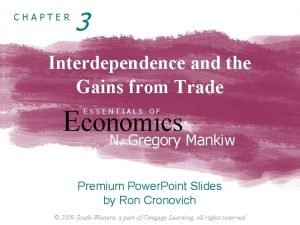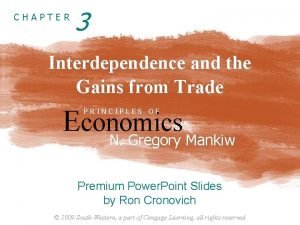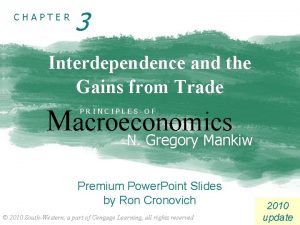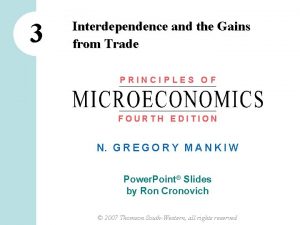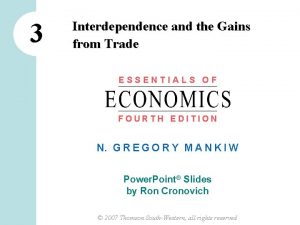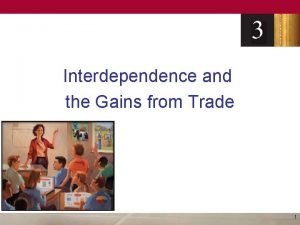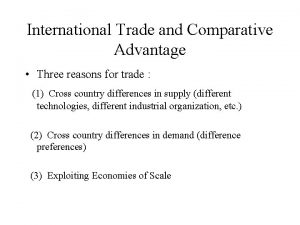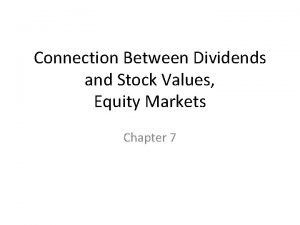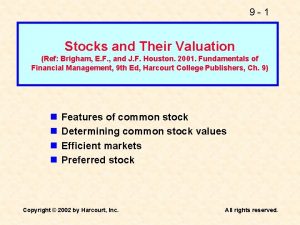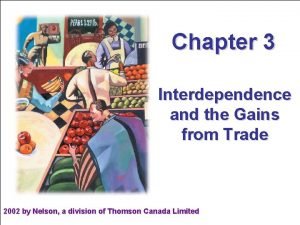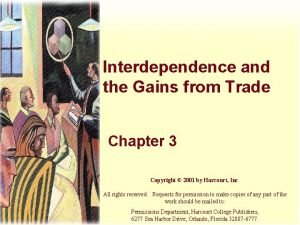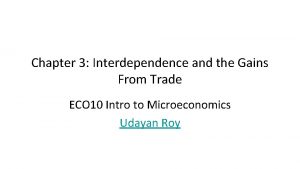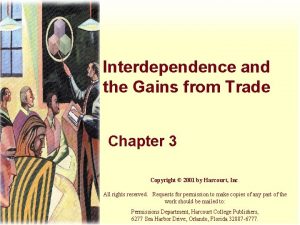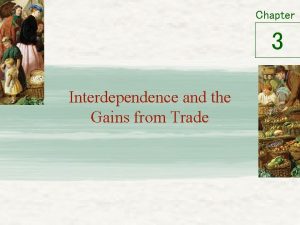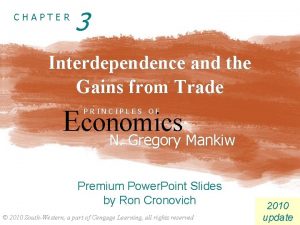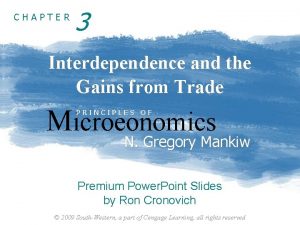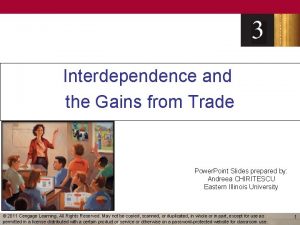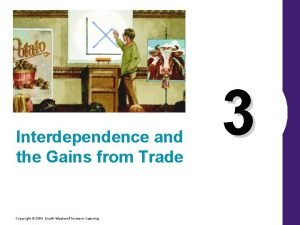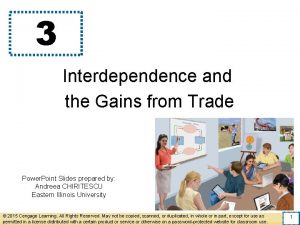CHAPTER 3 Interdependence and the Gains from Trade

















- Slides: 17

CHAPTER 3 Interdependence and the Gains from Trade Economics N. Gregory Mankiw ESSENTIALS OF N. Gregory Mankiw Premium Power. Point Slides by Ron Cronovich © 2009 South-Western, a part of Cengage Learning, all rights reserved

In this chapter, look for the answers to these questions: § Why do people – and nations – choose to be economically interdependent? § How can trade make everyone better off? § What is absolute advantage? What is comparative advantage? How are these concepts similar? How are they different? 1

Interdependence Every day hair gel from Cleveland, OH you rely on many people cell phone from around from Taiwan the world, most of whom dress shirt you’ve never met, from China to provide you with the goods coffee from and services Kenya you enjoy.

Interdependence § One of the Ten Principles from Chapter 1: Trade can make everyone better off. § We now learn why people – and nations – choose to be interdependent, and how they can gain from trade. INTERDEPENDENCE AND THE GAINS FROM TRADE 3

Our Example § Two countries: the U. S. and Japan § Two goods: computers and wheat § One resource: labor, measured in hours § We will look at how much of both goods each country produces and consumes § if the country chooses to be self-sufficient § if it trades with the other country INTERDEPENDENCE AND THE GAINS FROM TRADE 4

Production Possibilities in the U. S. § The U. S. has 50, 000 hours of labor available for production, per month. § Producing one computer requires 100 hours of labor. § Producing one ton of wheat requires 10 hours of labor. INTERDEPENDENCE AND THE GAINS FROM TRADE 5

The U. S. PPF Wheat (tons) The U. S. has enough labor to produce 500 computers, or 5000 tons of wheat, or any combination along the PPF. 5, 000 4, 000 3, 000 2, 000 1, 000 0 Computers 100 200 300 400 500 INTERDEPENDENCE AND THE GAINS FROM TRADE 6

ACTIVE LEARNING 1 Derive Japan’s PPF Use the following information to draw Japan’s PPF. § Japan has 30, 000 hours of labor available for production, per month. § Producing one computer requires 125 hours of labor. § Producing one ton of wheat requires 25 hours of labor. Your graph should measure computers on the horizontal axis. 7

Japan’s PPF Wheat (tons) Japan has enough labor to produce 240 computers, or 1200 tons of wheat, or any combination along the PPF. 2, 000 1, 000 0 Computers 100 200 300 INTERDEPENDENCE AND THE GAINS FROM TRADE 8

Basic international trade terms § Exports: goods produced domestically and sold abroad To export means to sell domestically produced goods abroad. § Imports: goods produced abroad and sold domestically To import means to purchase goods produced in other countries. INTERDEPENDENCE AND THE GAINS FROM TRADE 9

Where Do These Gains Come From? § Absolute advantage: the ability to produce a good using fewer inputs than another producer §NO! INTERDEPENDENCE AND THE GAINS FROM TRADE 10

Two Measures of the Cost of a Good § Recall: Another measure of cost is opportunity cost. § In our example, the opportunity cost of a computer is the amount of wheat that could be produced using the labor needed to produce one computer. INTERDEPENDENCE AND THE GAINS FROM TRADE 11

Opportunity Cost and Comparative Advantage § Comparative advantage: the ability to produce a good at a lower opportunity cost than another producer § Which country has the comparative advantage in computers? § To answer this, must determine the opp. cost of a computer in each country. INTERDEPENDENCE AND THE GAINS FROM TRADE 12

Opportunity Cost and Comparative Advantage § The opp. cost of a computer is § 10 tons of wheat in the U. S. , because producing one computer requires 100 labor hours, which instead could produce 10 tons of wheat. § 5 tons of wheat in Japan, because producing one computer requires 125 labor hours, which instead could produce 5 tons of wheat. § So, Japan has a comparative advantage in computers. Lesson: Absolute advantage is not necessary for comparative advantage! INTERDEPENDENCE AND THE GAINS FROM TRADE 13

Comparative Advantage and Trade § Gains from trade arise from comparative advantage (differences in opportunity costs). § When each country specializes in the good(s) in which it has a comparative advantage, total production in all countries is higher, the world’s “economic pie” is bigger, and all countries can gain from trade. § The same applies to individual producers (like the farmer and the rancher) specializing in different goods and trading with each other. INTERDEPENDENCE AND THE GAINS FROM TRADE 14

Unanswered Questions…. § We made a lot of assumptions about the quantities of each good that each country produces, trades, and consumes, and the price at which the countries trade wheat for computers. § In the real world, these quantities and prices would be determined by the preferences of consumers and the technology and resources in both countries. § We will begin to study this in the next chapter. § For now, though, our goal was merely to see how trade can make everyone better off. INTERDEPENDENCE AND THE GAINS FROM TRADE 15

CHAPTER SUMMARY § Interdependence and trade allow everyone to enjoy a greater quantity and variety of goods & services. § Comparative advantage means being able to produce a good at a lower opportunity cost. Absolute advantage means being able to produce a good with fewer inputs. § When people – or countries – specialize in the goods in which they have a comparative advantage, the economic “pie” grows and trade can make everyone better off. 16
 Chapter 3 interdependence and the gains from trade answers
Chapter 3 interdependence and the gains from trade answers Chapter 3 interdependence and the gains from trade
Chapter 3 interdependence and the gains from trade Chapter 3 interdependence and the gains from trade answers
Chapter 3 interdependence and the gains from trade answers Interdependence and the gains from trade chapter 3
Interdependence and the gains from trade chapter 3 Chapter 3 interdependence and the gains from trade summary
Chapter 3 interdependence and the gains from trade summary Interdependence and the gains from trade
Interdependence and the gains from trade Interdependence and the gains from trade
Interdependence and the gains from trade Gains from trade
Gains from trade How to calculate unexploited gains from trade
How to calculate unexploited gains from trade Trade diversion and trade creation
Trade diversion and trade creation Umich
Umich Trade diversion and trade creation
Trade diversion and trade creation Trade diversion and trade creation
Trade diversion and trade creation Liner shipping and tramp shipping
Liner shipping and tramp shipping Dividend yield and capital gains yield
Dividend yield and capital gains yield How to calculate dividend growth rate
How to calculate dividend growth rate Dividend yield and capital gains yield
Dividend yield and capital gains yield Cephalocaudal and proximodistal pattern diagram
Cephalocaudal and proximodistal pattern diagram
